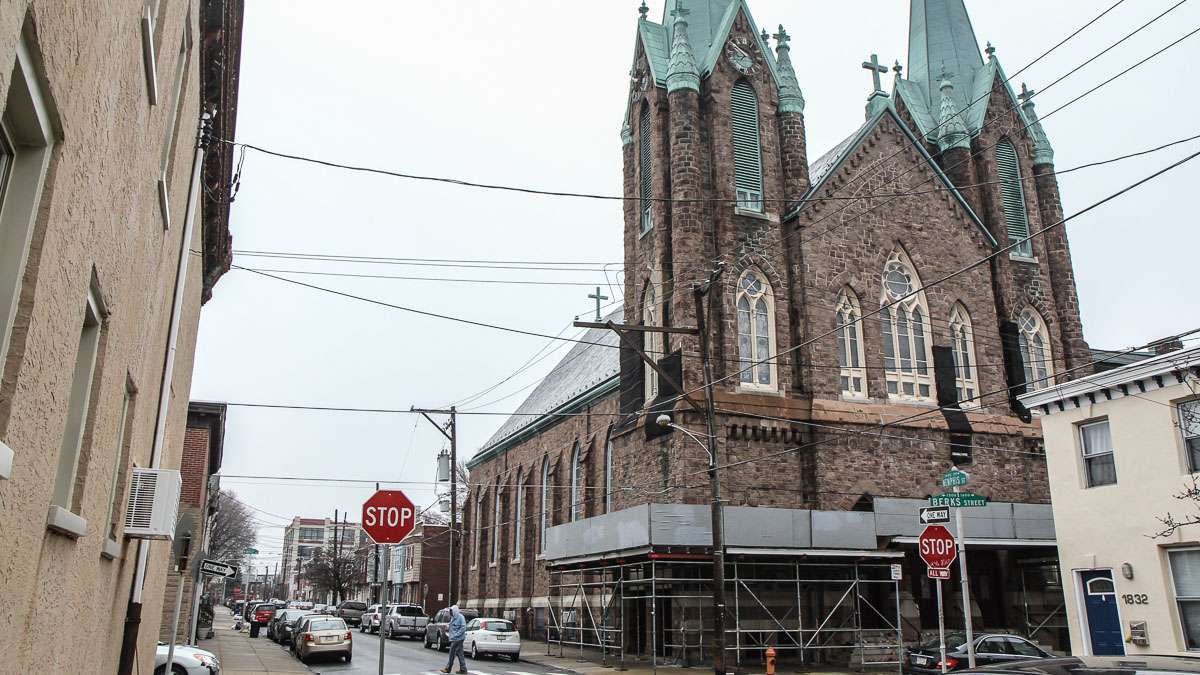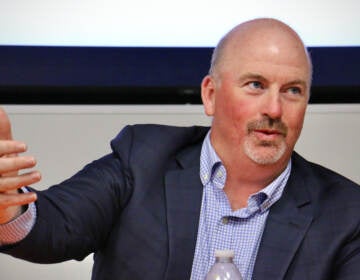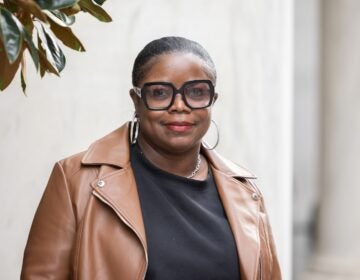With decision near on St. Laurentius, champions of Fishtown church carry on the mission
Listen-

-

-

Kimberly Paynter/WHYY)
-

-

-

The fight to save the oldest Polish church in Philadelphia is heating up. On one side is the Archdiocese of Philadelphia, which merged the old church with a nearby parish two years ago and has been trying to sell it ever since.
On the other side are dozens of former parishioners of the Fishtown church and other community activists who have pooled their resources to form an opposition that’s gaining momentum.
The fate of the empty church is expected to be decided next month by the city’s Historical Commission.
That meeting was on the mind of Kate Gaber as she sat on a yellow school bus with 30 other people just like her: lifelong Fishtown residents who’ve spent their whole lives going to St. Laurentius.
“This is heartbreaking because of the community. It’s not just a church. It’s a community,” Gaber said. “Friends and family that grew up together. And we don’t have that anymore.”
Gaber and the whole bus crew, decked out in white shirts with “Save St. Laurentius” written in bold red letters, were on their way to a public hearing over the future of the church.
Gaber was a parishioner for 43 years. Her husband’s family attended for 70 years. All her children were baptized and married in the church. And as long as Gaber can remember, the church has been a symbol of her identity, a marker of her place in Philadelphia.
“Because whichever way you come, you see our steeples and you know, ‘Oh, OK, we’re here, we’re in St. Laurentius.’ If you give anyone directions to go anywhere, ‘Oh, well, you’ll come upon this church, and it has these big green steeples, and you’ll know you’re close to where you wanna go,'” Gaber said.
But ever since the archdiocese combined St. Laurentius with Holy Name, a traditionally Irish parish just down the street, the question has been asked: What to do with the empty church from the 1880s?
Preservation or demolition
An engineering firm presented the archdiocese with basically two options — invest millions into the church to preserve it or demolish it and sell the land. Church officials have decided on the second course.
“You got two things. You got the health and safety issue with a building that may fall down without warning, or portions may fall down without warning, and then you have to figure out how the parish is going to be sustainable, said Ken Gavin, a spokesman for the archdiocese. “And since the parish is responsible for its finances, it has to take a fiscally prudent approach, so that there is a Catholic church presence in Fishtown.”
The combined parish is running an operating deficit of $4 million annually, Gavin said. In order to finance the demolition – said to cost $1 million – the parish would have to sell a building and a nearby garage.
From a purely financial perspective, it makes sense. Repairing the building is costly. Long vertical cracks scar the façade; one of the towers is leaning six inches off center; and seeping water has left it damaging marks.
The Archdiocese estimates it pays $40,000 a year to just maintain the property, which is surrounded by scaffolding and netting.
Supporters of preservation, however, see more than the cost-benefit analysis.
The brownstone and granite building was constructed by E.F. Durang, who did a spate of Catholic churches in 19th-century Philadelphia, according to Aaron Wunsch, who teaches architectural history in the University of Pennsylvania’s graduate program in historic preservation.
“He was really the go-to architect,” he said. “He came from a family whose background was in the theater. So he has a real sense for the theatrical, which is appropriate for a building like this.”
A touchstone of city’s Polish history
The Gothic revival style and soaring copper spires — green from decades exposure to the elements — give the church a 19th century signature. But the building represents something more to the community.
“This is a building which is central to the history of the Polish community in the city of Philadelphia,” Wunsch said. “This building was really built as a kind of showpiece or a bulwark announcing that they had come, and not only come but done well enough to build something like this.”
Cathy Plunkett, another longtime resident, has memories of Fishtown over the years deeply connected with the area’s Polish roots.
“The funeral home, Osiecki’s, was right there. That was Polish. Bill’s deli. Him and his wife are both from Poland. The accents there were very thick,” she said with a laugh.
In Fishtown, you can hear the gentrification, in a sense, by tuning in to how the sounds on the street have changed.
“A lot of the voices, the strong voices came from your factory workers, your union workers that are older and they’ve either gone into retirement homes or moved away, passed away,” Plunkett said. “The neighborhood has a lot of professionals, so when they speak it’s more quiet, it’s not as boisterous.”
An influx of ‘dog-walkers’
Kate Gaber has another name for the newcomers.
“We call them our dog-walkers. A lot of them have dogs, they don’t have kids,” said Gaber. She’s a dog person, she says, so she doesn’t hold it against them.
But one afternoon, while she was selling St. Laurentius shirts outside of the closed church, some of the dog-walkers stopped by.
“And they bought the shirts. And they said to us, ‘Anything to support, because it’s a beautiful place. And if they rip it down, what are they gonna build there?'” Gaber recalled.
This leads to a striking aspect of the movement to stop demolition. The people behind the church’s social media activism, those leading the community meetings, the ones talking to the press are not residents with old Polish roots. They’re newcomers to the neighborhood. Young professionals.
Take William Ellerbe. He and his wife recently purchased a house near the church, and they attended a community meeting about the church some months back. A.J. Thomson, an attorney who grew up in Fishtown, has become a bulldog for the St. Laurentius cause. He led the meeting.
“You got this immigrant community, and they built this beautiful church. The effort and the money that went into that is such a testament to what that community was and what it thought of itself. It still is such a beautiful building,” Ellerbe said. “You can’t rebuild 133-year-old buildings.”
Retired Temple University anthropologist Judith Goode, who studies how the city’s immigrant neighborhoods have changed, said it’s not surprising that the newcomers are joining the fight.
An existential instinct
“I had someone say to me once, ‘I walk out in the neighborhood and hear so many languages, it makes my adrenaline flow,’ and so, that’s what they’re trying to consume — this valuable essence of diversity. And, absolutely, that’s a majority dynamic,” Goode said. “You have two allies who are involved in this process, and they have mutual interests, but not identical interests.”
Polish immigrants came to Fishtown around the turn of the century lured by old, affordable housing stock built around factories, she said. But as white Catholics began to intermarry, and, later, industry broke up, Philadelphia’s Polish community started moving to different parts of the city. Many leap-frogged to the Port Richmond-Bridesburg area, which still has the densest concentration of residents with Polish roots.
Although resistance to the demolition of St. Laurentius hasn’t gone far beyond Fishtown residents, Goode said the remaining Polish community in the neighborhood see it as an almost existential fight.
“And you have to think of their protest as meaning a lot more than just about retaining a Polish ethnic community,” she said. “It’s about retaining an older way of life, when they were respected and didn’t feel that their position in society was so tenuous.”
When the bus arrived at City Hall and the church’s champions pushed their way into tiny room where a committee of the Historical Commission was meeting, passions flared on both sides. Jeers, cheers and interruptions marked the proceedings.
During one passionate exchange between the Rev. John Sibel, who was appointed to oversee the combined parishes, and architect David Traub, a supporter of saving the church, the crowd whooped in delight.
“If we’re divided we will not survive. Thank you for saying that,” Sibel said, referring to an earlier comment from Traub.
“I was referring to the archdiocese itself,” Traub quickly replied. “Which, in my view, must take responsibility for this and see the historic architectural urbanistic importance of this church. I know the parish itself cannot afford it.
“But I think the Archdiocese must establish a new paradigm and come to the rescue of these very important churches throughout this region,” he said. “And this is not the last instance of church that needs to be saved.”
Decision expected in July
In the end, the committee recommended that St. Laurentius be protected from demolition. The full Historical Commission will have the final say about whether to save, or demolish, the church.
But, as Goode noted, activists in this neighborhood have a poor track record over the decades of trying to save old churches.
“This has been happening in North Philadelphia. This is like one of the last,” she said. “And there have been uprisings, and there have been demonstrations, and there has been action. Strong, concerted action among people who have been activists for years, to no avail.”
Old residents and new ones, though, are hopeful that they can beat the odds.
They say they’ve raised $500,000 in pledges they can use to start fixing the church if they prevail. They also have the endorsement of City Council President Darrell Clarke, which they hope to use to score political points.
But, even if they win, the questions become: Is there a functional use for the building? And will the archdiocese give it up?
If the church prevails, Wunsch said, divisions might emerge among the coalition of people who’d banded together to fight back. Still, unlike other churches facing the wrecking ball, St. Laurentius has a rare commodity.
“This is not a building without a group that wants to occupy it,” Wunsch said. “This is a building with a group that passionately wants to reoccupy it.”
WHYY is your source for fact-based, in-depth journalism and information. As a nonprofit organization, we rely on financial support from readers like you. Please give today.




